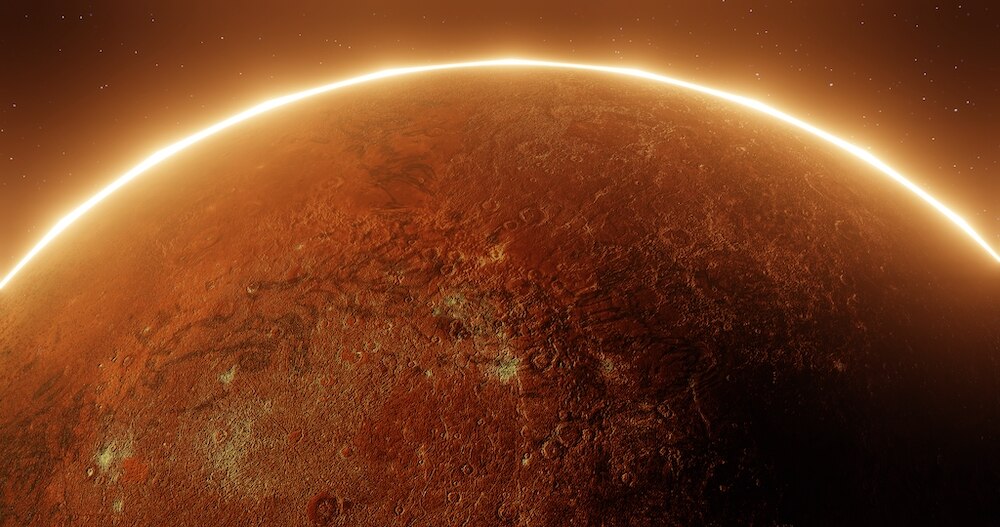Create a free profile to get unlimited access to exclusive videos, sweepstakes, and more!
This is what Mars is really like skin-deep
Layers in the Martian subsurface are sort of like those in our skin, but made of rocks, rocks, and more rocks.

You know how your skin has layers — epidermis, dermis, hypodermis? Planets really aren’t that different when it comes to what lies right beneath the surface.
As Perseverance crawls across Jezero crater looking for signs of fossilized microbes, NASA’s InSight lander uses its SEIS assembly of seismic instruments for taking measurements which can tell scientists about the deeper levels of the Martian crust. Craters on the surface give away asteroid impacts. What remains of ancient lava flows that Mars is hiding beneath its dusty red exterior (which you could call its epidermis) are evidence of its volcanic past.
The "epidermis" of Mars is made of that reddish, rocky regolith you see in all the images captured by rovers. Beneath the red dust is ejecta shrugged off by asteroids. Basaltic rocks from ancient lava flows make up the "dermis," but a team of researchers led by geophysicist Cédric Schmelzbach from ETH Zurich found something unexpected between the upper and lower layers of basalt. They recently published their findings in Nature Communications.
“For this study, we analyzed the ambient ground vibrations that SEIS records constantly,” Schmelzbach told SYFY WIRE. “The signature of seismic waves measured at a particular area has a distinct imprint of the local subsurface structure.”
But first, the epidermis. For the uppermost layers of crust, the researchers used InSight’s seismic sensor to hear the noise made by the thermal probe (which measures heat escaping the inner depths of the planet) so they could get an idea of what was below ground from seismic velocities. Seismic velocity is the rate at which a seismic wave travels through a substance, in this case regolith, and is most affected by how porous that substance is. The seismic velocities at the InSight landing site were low — that happens when a wave passes through loose sand.
Those infamous dust storms on Mars actually helped with pressure and seismic measurements that revealed what could not be seen. After you get about 10 feet deep, the subsurface grows more rigid, which means that there are larger chunks of rock in the regolith, and eventually, that transitions into much stiffer rock that indicates basalts formed by solidified magma. Seismic waves generated by the wind told Schmelzbach and his team what the dermis was made of. There were two layers of lava flows, but they didn’t think they’d find sediment between them.
“Low seismic velocities were the main evidence for sedimentary deposits,” he said. “Based on our experience from studying lava flows and sedimentary rocks on Earth, we expected the basalts to be much more rigid than the weak sediments, as observed by rovers on Mars.”
Subsurface materials can vary as much as their ages, from 1.7 to 3 billion years old. This is the first time real subsurface measurements have been compared to previous predictions, and they show Mars is more complex under its skin than it was thought to be. So the dermis would be the top basalt layer and that newly discovered sediment. Because the dermis in humans is a thicker layer of skin than the "hypodermis," that would mean the hypodermis of Mars would be that last layer of basalt beneath the sediment.
Marsquakes can also tell us about what happens deeper inside the planet. InSight has been able to beam back data that was used to find out more about the core of Mars, which it turned out to be about half the size of Earth’s. Seismic measurements could also potentially find subsurface deposits of water ice. This would be especially important for a crewed mission to Mars, if that ever happens. Ice is denser than dry, loose regolith, so it would increase the seismic velocity. More insight will be needed for this, and not just from InSight.
“Without additional information, seismic velocity estimates on their own may not be enough information to tell apart high velocity due to ice from high velocity due to, for example, basaltic rocks,” Schmelzbach said. “Finding an answer to this is not going to be easy.”
Whether the beauty of Mars is beyond skin deep is subjective. You have to be into rocks.


























